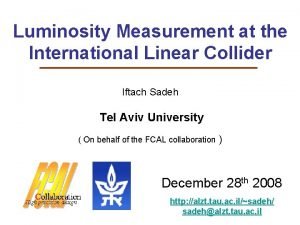SRF Cavity Designs for the International Linear Collider

- Slides: 1

SRF Cavity Designs for the International Linear Collider* L. Xiao, A. Candel, A. Kabel, Z. Li, C. Ng, K. Ko, V. Akcelik, L. Ge, R. Lee, E. Prudencio, G. Schussman, R. Uplenchwar, S. Chen, SLAC; J. Sekutowicz, DESY; T. Higo, K. Saito, KEK SLAC is contributing to the design of SRF cavities for the International Linear Collider (ILC) by performing highly accurate, high fidelity electromagnetic modeling using the advanced tools developed under the US DOE Sci. DAC program. The parallel finite element codes include the eigensolver Omega 3 P for calculating mode damping, S 3 P for finding S-parameters, the time-domain solver T 3 P for computing wakefields and the particle tracking code Track 3 P for simulating multipacting and dark current. We present the results from their applications to the ILC main linac cavity including the baseline TDR design and the alternate Low-Loss and Ichiro designs, and also to the 3. 9 GHz deflecting cavity for the interaction region. ICHIRO Cavity Baseline TDR Cavity – Cavity Imperfections Multipacting Barriers HOM Notch Filter Notch gap 1 Cell elliptical distortion split Cell length distortion Ideal cavity scatter Notch gap (mm) shift Comparing measurements (color) with Omega 3 P (black) eigenmode solutions shows data scatter around ideal cavity results due to shape deformations Gap Tuning Antenna tip dr=0. 25 mm Track 3 P Cell deformation: l elliptical shape increases frequency split l cell length error causes frequency shift. Low-Loss Cavity - End Group Optimization l l ICHIRO single cell reached ~ 50 MV/m @ KEK 9 -cell cavities can’t process above 30 MV/m Notch gap field (MV/m) @30 MV/m Antenna tip Field (MV/m) @30 MV/m Qext of HOM port @1. 3 GHz Upstream Downstream 1. 63 16. 9 5. 0 0. 8 0. 2 6. 1 e+9 1 e+12 1. 73 16. 5 4. 9 1. 4 0. 4 5. 2 e+8 9. e+9 2. 73 13. 3 3. 9 6. 1 3. 0 1. 4 e+7 1. 7 e+8 3. 9 GHz Deflecting Cavity Damping 1 st monopole band 1 st dipole band 2 nd dipole band 400 450 5. 0 By adjusting the end-pipe radius, the HOM coupler azimuthal location, and the loop shape and configuration, the Qe of the dangerous 3 rd band mode was reduced to below stability threshold (Qe<105). Similar improvements carried out for the ICHIRO cavity which is based on the LL design. * Work supported by DOE contract DE-AC 02 -76 SF 00515 HOM Coupler SOM Coupler Input Coupler LOM Coupler Operating Mode Solid – FNAL design Hollow – w/ SLAC modifications

